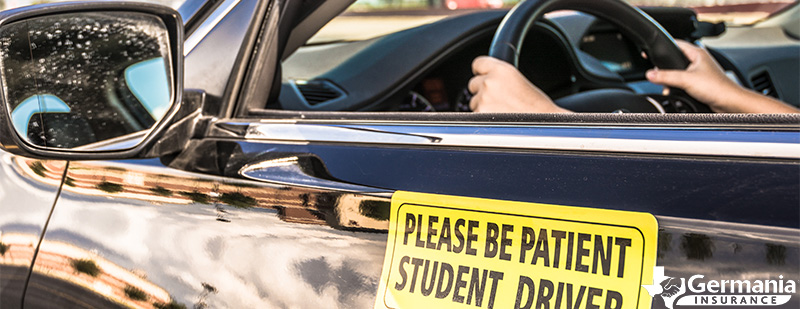Find out everything you need to know to help your teen get a driver’s license in Texas!

Time has flown - your child is a teen! And now, they're probably relentlessly asking to get their first taste of freedom; to finally get a driver's license. From practicing in the family car to holding the card in hand, getting a driver’s license is a rite of passage for many teenagers. But, as you know, the actual process isn’t as easy as taking a single test and then grabbing the keys.
If you and your teen are ready to start the driver’s license journey, read on to learn about the phases designed to help them build skill and confidence on the road before they receive a full license.
How old do you have to be to get a driver’s license in Texas?
The age of 16 is nearly synonymous with getting a driver’s license. However, the process can start much earlier. Teens who aren’t 18 yet have to complete a driver’s education course before getting any kind of license. To begin the classroom portion of their education, they must be at least 14 years old. To get a learner’s license, however, your teen must be 15 years old and once they’ve held their learner’s permit for at least 6 months and are ready to receive their provisional license, they must be 16 years old. This temporary license expires on their 18th birthday, and they will have to receive an updated license suitable for adults under 21 years of age.
Driver’s education for teens in Texas
When your teen is at least 14 years old and your family is ready to choose a driver’s course, you have four main options to consider.
Traditional Driver Education. Attending a conventional driving course through a certified driver training school often includes in-person classroom training over 4 or more weeks to meet education requirements. Your teen would take classes with other teens and be guided by professionals as they study for and take the DPS written test and have in-car lessons to teach teens safe driving.
You can find approved driver's license programs and driver education options on the
Texas Department of Licensing and Regulation (TDLR) website.
Online Driver Education. Also offered by certified driver training schools, online driver education can be a schedule-friendly and financially accessible option. Using learning modules, online education is self-paced, and progress is measured through quizzes that must be passed within 3 attempts. You can check the Texas Department of Public Safety (Texas DPS or TDPS) website to find an approved driver education course.
Parent-taught Driver Education (PTDE). According to the Texas Department of Licensing and Regulation, PTDE requires a minimum of 76 hours of classroom and in-car instruction to complete.
Follow TDLR’s guide for parents to ensure you record the education hours correctly.
Public School Driver Education. Not every Texas public school offers driver education. However, if your teen’s school does, this can be a particularly accessible option for your family. Check with your child’s school for the details.
Types of Texas driver’s licenses
Once your teen has the required education, they can head over to TDPS and get their first license. Through the Graduated Driver License (GDL) Program, your teen will go through two phases of licensing before they can receive their full license. We’ll walk you through the phases below.
Phase I: Learner’s License or Learner’s Permit
A Texas learner's license or Texas learner’s permit is an entry-level restricted driver's license for teens 15-17 years old who need to practice driving with an adult licensed driver in the vehicle.
To receive a learner’s license, your teen must complete the first 6 hours of their driver's ed course if it uses the concurrent method for classroom instruction. If the course uses the block method for driver education, first-time drivers must complete all 32 hours.
They must also have documentation proving one of the following:
- They have a high school diploma or equivalent (GED)
- They are enrolled in and attended school for at least 90 percent of the time in the fall or spring semester before their application date
- They are enrolled in a program to prepare them to pass a high school equivalency exam and have been for at least 45 days
- If they are applying in the summer, a report card for the most recent school year that includes their name, list of absences, and grades
With those requirements met, you or your teen are ready to schedule your appointment with TDPS. One of your teen’s first acts of responsibility as a new driver may just be gathering all the documents for their appointment. Here’s what they’ll need:
- A completed learner’s license application available on the TDPS website or at your local Driving License offices
- Provide proof of US Citizenship or evidence of lawful presence
- Proof of Texas Residency
- Proof of Identity
- Social Security Number
- Evidence of Texas Vehicle Registration for each vehicle you own if you are surrendering an out-of-state license
- Proof of auto insurance for each vehicle
- Texas Driver Education Certificate
- Verification of Enrollment and Attendance (VOE)
With these in hand, head to your teen’s appointment. Along with an application fee, your child will provide a signature and fingerprint, and a vision test and photo will be taken at the office. Double-check your teen’s documented information before leaving the office, and then you’re good to go! They will receive their license in the mail in 2-3 weeks.
There are many driving privileges that your child will have even with their permit. It’s important to remind them of ways to practice safe driving and of the limitations of their license.
Here are a few reminders about a learner’s permit:
- There must be a licensed adult, 21 years or older, in the passenger seat while the teen is driving.
- Teen drivers must hold their learner’s permits for six months or until they turn 18, which is when they expire.
- Drivers must not use wireless communication, including hands-free, unless it’s an emergency
- If a teen driver’s license is suspended while they have their learner’s license, the 6-month period increases by the number of days suspended to make sure the teen completes a full and valid 6 months.
Phase II: Provisional Driver's License
After 6 months of practicing, learning more driving skills, and becoming more comfortable on the road, your teen will be able to get a provisional driver’s license if they aren’t 18 yet.
While having a learner’s license for 6 months is one major requirement, teen drivers also have to complete the behind-the-wheel portion of their Texas driver’s ed and the Impact Texas Teen Driver program within 90 days of the provisional license skills test.
With those educational requirements met, your teen can prepare for the provisional license application. Here is what your teen will need to apply for a provisional license:
- A completed provisional driver’s license application
- A parent or guardian present at the appointment or their signature notarized on the application
- Evidence of lawful presence if you are not a U.S. Citizen
- Proof of identity
- Texas Driver Education Certificate of Completion
- Impact Texas Driver Program Certificate of Completion
- Evidence of successfully passing the driving test
Driving tests can be completed at the DL office or through a third party. If you need accommodations for your test, reach out to the DPS. Driving tests at your local driver's license office require that you schedule an appointment online and provide proof of the registration and insurance for the vehicle you’ll be testing with. If you took the driving test at a driver training school, you must provide the results at the time you’re applying for your license in a sealed envelope provided by the school.
Then, similar to their learner license process, your child will provide a signature and fingerprint, and a vision test and photo will be taken at the office. Finally, they will need proof of vehicle insurance and an application fee.
Once you have your license, check that your information is correct before leaving the office. Then look out for your new card, which will arrive in 2-3 weeks via mail.
Teen drivers see a substantial increase in their driving privileges when they no longer have a learner’s permit. As parents, this may be an excellent time to make sure you’re setting a great example for your teen and to set ground rules for driving. A good place to start is Texas’s own rules for a provisional driver:
- You may not drive with more than one passenger under the age of 21 who is not a family member.
- You may not drive between the hours of midnight and 5 AM unless it’s for work, a school event, or a medical emergency.
- Drivers should not use wireless communication devices, including hands-free devices, unless it’s an emergency.
Your teen’s provisional license will expire on their 18th birthday. The license can be renewed online or in the TDPS office up to 30 days before the expiration. If they choose to renew in person, your teen will need to bring a parent or legal guardian. If they visit the office after their 18th birthday, they don’t need a parent or guardian, but they must make arrangements to visit the office without driving because their license will be expired at that point, and they would be violating state law by driving with an expired license.
Other types of licenses in Texas
Motorcycle License
While motor vehicles like cars are Class C licenses, a motorcycle license is a
class M license. However, teens aged 15-17 can enroll in a motorcycle safety course if they have a Class C learner license and have completed 32 hours of classroom driver education, present a certificate of completion for the classroom phase of a driver education course, or have a provisional license.
Find out more about Class M licenses at the TDPS website.
Hardship License
In certain instances where it’s necessary for applicants under the age of 16 to hold a provisional license, a minor’s restricted driver's license (MRDL), also known as a hardship license, may be issued. Applicants must be 15 years of age and still have to complete driver's education and the requirements for a license, they just won’t need to hold a learner license for 6 months. This license will expire on the applicant's next birthday.
Find out more about the hardship license application process on the TDPS website.
When your teen completes the GDL program for obtaining a full license, they will have a full license. But before then, they will need all the help and support they can get. From conversations about
defensive driving to implementing curfews, your teens will be looking to you for guidance just as much as any educator. Make sure to also
check out our blog discussing tips for parents with teen drivers to help you along the way.
Good luck to you and yours!
 If you're looking to insure your driver, Germania Insurance has you covered. Request a free quote online or reach out to one of our trusted Authorized Agents today!
If you're looking to insure your driver, Germania Insurance has you covered. Request a free quote online or reach out to one of our trusted Authorized Agents today!